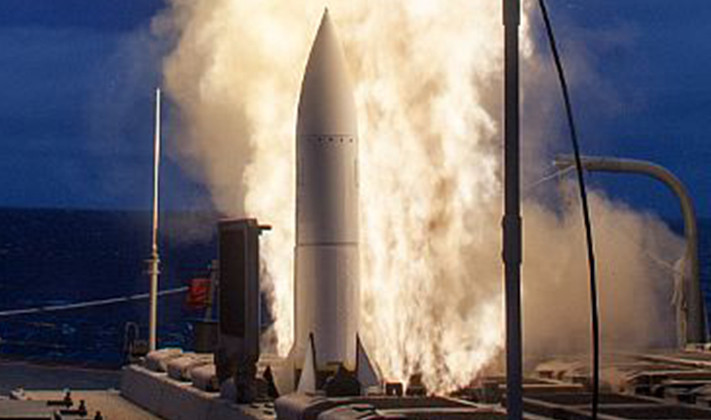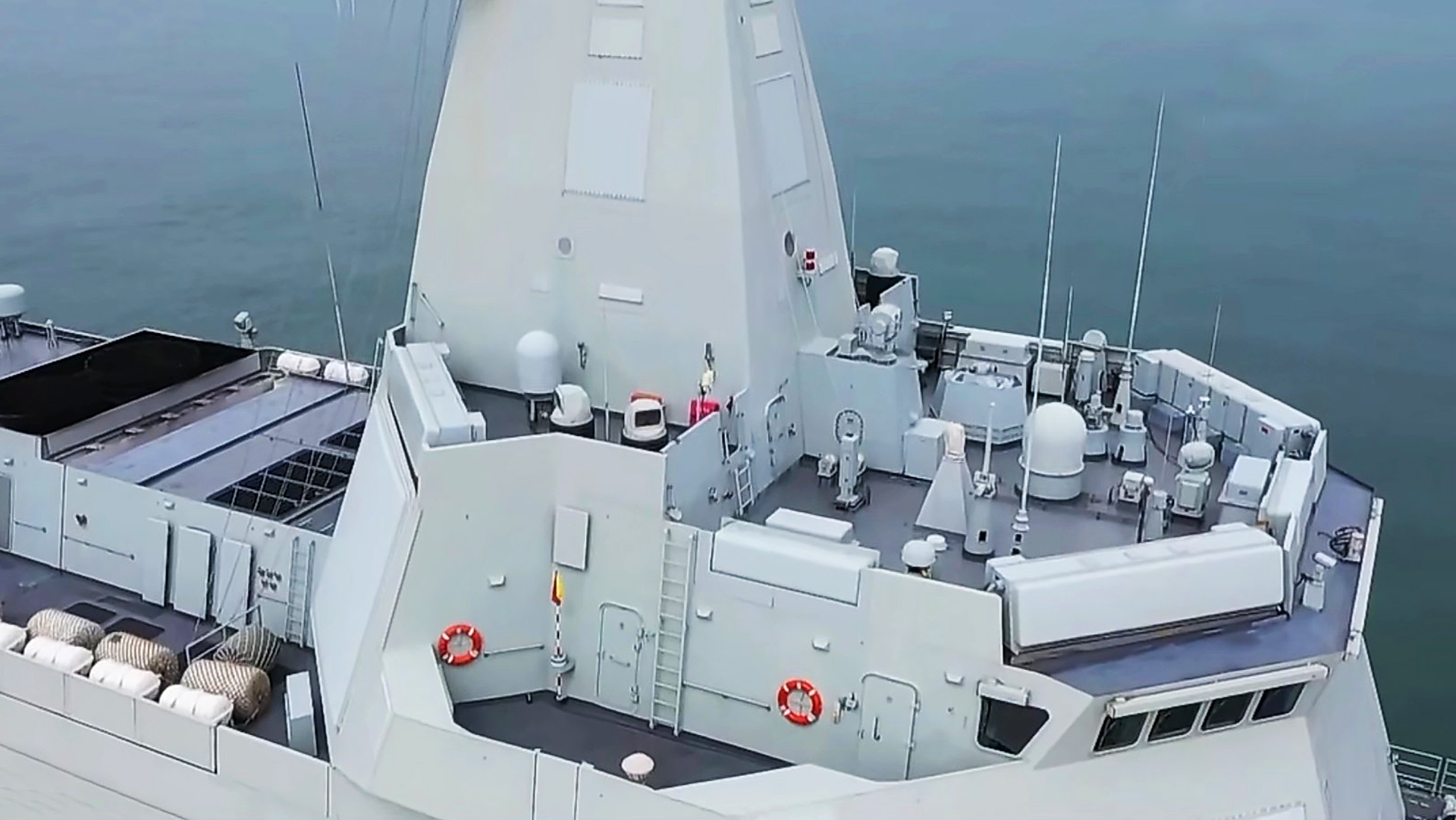A series of relatively high-resolution and close-up images of the Chinese People’s Liberation Army Navy’s Type 055 destroyer Nanchang, which has the hull number 101, have appeared online. The pictures offer an unusually detailed top-down look at the armament, defensive systems, and other features of the warship, which is China’s most modern and capable surface combatant. At least two Type 055s are now reportedly moving into position to take part in a series of drills aimed at Taiwan in response to U.S. Speaker of the House Nancy Pelosi’s recent visit to the island, where their capabilities could be put on full display.
The images in question all appear to be screenshots from a segment broadcast on a Chinese-language television station, which were then posted online via the country’s microblogging website Weibo. The lower thirds in all of the shots include the years “1927” and “2022.” This strongly suggests that this was part of a broadcast on or about August 1 marking this year’s China’s People’s Liberation Army (PLA) Day, also referred to simply as Army Day. The PLA traces its founding to the Nanchang Uprising, which took place on Aug. 1, 1927.
It’s unclear where these shots of Nanchang were taken, but it’s possible that the ship is seen here pier side at its homeport in Qingdao in Shandong province in northeastern China. Whatever the case, they give an unusually clear look at various key elements of this ship, which was the first Type 055 to be commissioned, officially entering service in 2020. Since then, at least six more of these warships, which incorporate some low-observable (stealth) design features, have been built. More are in various states of construction. Chinese media reports in the past have indicated that a total of at least 16 are eventually expected to join the PLA Navy’s battle fleet.
At just over 590 and a half feet long and with a full displacement of between 12,000 and 13,000 tons, the U.S. military, among others, categorizes the Type 055 design, also known in the West as the Renhai class, as a cruiser rather than a destroyer. For comparison, the U.S. Navy’s future expanded Flight III Arleigh Burke class destroyers will be 509 and a half feet long and displace around 10,864 tons. In terms of general lengths and displacements, the Type 055s, are also larger than the Navy’s 567-foot-long and 10,752-ton-displacement Ticonderoga class cruisers.

The overhead shots give a good look at Nanchang‘s 112 vertical launch system (VLS) cells. This is more VLS cells in total than a Flight III Arleigh Burke class destroyer (96 cells), though slightly fewer than the on a Ticonderoga class cruiser (122 cells). This is also more missile-launching capacity than is currently found on the U.S. Navy’s Zumwalt class stealth destroyers (80 cells), which are larger overall than China’s Type 055s.
The VLS design found on the Type 055s, which is also used on the PLAN’s Type 052D destroyers, is notably different from that of the Mk 41 and Mk 57 systems found on current generation U.S. Navy warships.
The cells used in the Chinese “universal” system are larger than their American counterparts as a byproduct of their ability to both hot and cold-launch missiles. A hot-launched missile is on where the main rocket booster ignites while it is still inside the launcher, while a cold-launched is ejected in some fashion, often using a compressed gas generator, first, before the booster ignites.
It’s not entirely clear how the firing of hot-launched missiles work, but they appear to be loaded into the cells inside a sleeve that contains the flame when they are fired. This could obviate the need for a dedicated channel of some kind to vent the flame away from the missile – something that appears to be absent when looking at the top-down shots of Nanchang – as is found on U.S.-made Mk 41 and Mk 57 arrays. It has been postulated this could allow cold-launched missiles designed for these cells to be able to be designed in a way that maximizes the available space, and therefore be larger than hot-launched types that can also be loaded into these arrays, since they do not require the protective sleeve.




It’s also possible the arrays have a venting system that just isn’t apparent in the images.
Whatever the case, the Type 055’s VLS arrays are designed to be able to be loaded with a variety of different air-to-surface and surface-to-surface missile types. The system is reported to be able to at least fire members of the YJ-18 and CJ-10 families of land-attack and anti-ship cruise missiles, the YJ-83 anti-ship cruise missile, the HQ-16 and HQ-9 surface-to-air missiles, and the Yu-8 rocket-assisted torpedo. The DK-10 surface-to-air missile, developed for export and that does not appear to have been not adopted by the PLA, can reportedly be launched from one of these cells, too. Other missiles that are compatible with this VLS are in development, including ballistic missiles, as you can read more about here.

In addition to the VLS arrays, the Type 055 has a H/PJ-38 130mm naval gun in a turret at the bow, as well as an 11-barrel 30mm H/PJ-11 close-in weapon system (CIWS) in front of the main superstructure. A 24-cell HQ-10 short-range surface-to-air missile launcher sits on top of the ship’s helicopter hangars – which were designed primarily for Harbin Z-9s, but may be able to accommodate the PLAN’s new Z-20Fs – at the stern. The H/PJ-11 and the HQ-10 launcher, the latter of which is broadly similar to RIM-116 Rolling Airframe Missile (RAM) launchers in service with the U.S. Navy, are both intended for close-in defense, particularly against incoming anti-ship cruise missiles.

The flight deck on the Typer 055 is deceptively large, offering ample room for even larger helicopters.
When it comes to countermeasures, the top view shots of Nanchang offer a good look at the four Type 726-series defensive launchers, two of which are mounted on either side of the aft section of the ship’s superstructure. These 24-cell launchers can reportedly be loaded with flares, cartridges full of radar-blinding chaff, active decoys equipped with small radiofrequency jammers, and anti-submarine rockets with small depth charges. The first two types are intended primarily to protect against incoming anti-ship missiles, while the latter ones are intended to be used to engage submarines, incoming torpedoes, and combat divers.


However, what is perhaps most interesting is the very clear view of an array of what appear to be boxy antennas mounted along the edge of the top of Nanchang‘s bridge. This is a feature of the Type 055 design that has not been conclusively unidentified, with various sources speculating that it could be a key part of the ship’s electronic warfare (EW) suite.

The Type 055s are certainly understood to have some degree of electronic warfare (EW) and electronic support measures (ESM) capabilities. This reportedly includes electronic attack capability and the ability to spot, track, and categorize potentially hostile radars and other signal emitters.
The EW/ESM systems are, at least in part, fixed-face arrays installed on the lower portion of the sides of the main forward superstructure (as well as possibly on either side of the hangar structure), not to be confused with the ones associated with its Type 364B Dragon Eye active electronic-scanned array multi-function radar. Together, they could give the ship the ability to execute some degree of electronic attacks, as well as spotting, tracking, and categorizing potentially hostile radars and other signal emitters.
The S-band Dragon Eye radar is also supplemented by an X-band radar that utilized fixed-face scanned array antennas mounted on the ship’s integrated mast, which provides for more precise tracking of smaller, stealthier, and faster-moving targets, as well as weapons guidance. There are additional fixed-face arrays on the mast that may be linked to EW/ESM systems or additional radars.


The Type 055s have basic navigation radars, bow-mounted and towed sonars, and electro-optical and infrared sensor systems, too.

One thing that seems to be missing, when compared with its foreign counterparts, are various large beyond-line-of-sight communications domes. While there are some smaller satcom systems visible, and one larger one, it makes one wonder about the long-range secure communications and networking capabilities of these and other Chinese warships. This, of course, is not as pressing of an issue when operating regionally, but considering China has global ambitions for its navy, and especially the Type 055, it is something to ponder.
If nothing else, this clearer top-down look at Nanchang simply underscores the modernness of the Type 055 design, at least outwardly. These ships are a prime example of the significant efforts the PLAN, as well as the rest of the PLA, has made to improve its capabilities and expand its ability to project power in recent years. The speed with which the Chinese are building these ships is separately representative of the impressive shipbuilding enterprise the country has been able to establish to support its naval modernization goals.
Last year, Nanchang became the first Type 055 to sail as a carrier escort. This is expected to be a primary role for the entire class, especially as the PLAN’s carrier fleet grows. At the same time, they will likely continue to be important components of other surface action groups tasked with operating far from China’s shores, and will be able to conduct independent operations, too.
With all this in mind, it’s not at all surprising that the PLAN appears to be deploying multiple Type 055s to take part in a series of what look set to be worrying aggressive exercises aimed squarely at Taiwan. The drills are in direct retaliation for a recent visit there by U.S. Speaker of the House Nancy Pelosi.
A report earlier today from Global Times, a newspaper affiliated with the ruling Chinese Communist Party, has indicated that there could be unprecedented and potentially dangerous shows of force, including the firing of missiles over the island. The exercises are currently scheduled to begin tomorrow and run through the weekend, and you can read more about what they might entail here.
It is, of course, worth noting that the Type 055 has yet to demonstrate any of its reported capabilities in actual combat of any kind. It is also unclear to what standards these destroyers or their various subsystems might have been constructed. In June, Italian defense news website Geopolitica.info published a story saying that the Pakistani Navy has been experiencing significant issues with its Chinese-made Zulfiquar class frigates, with problems impacting various key systems, including their engines, weapon systems, and sensors. The Zulfiquar design is an improved derivative of the Type 053H3 developed specifically for Pakistan. That report remains unconfirmed, but it is a reminder that there are many unknowns as to how capable China’s new warships actually are, despite how impressive they may look or what their stats may be on paper.
No matter what, while the new views we now have of Nanchang are the best look we’ve had of one of these Chinese super destroyers, we can only expect to be seeing a lot more of these ships in the coming years.
Contact the author: joe@thedrive.com
